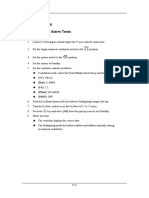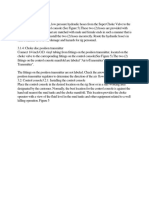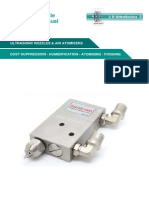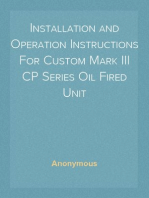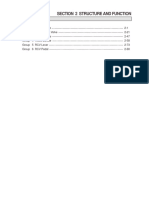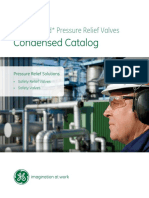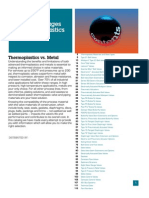Ection Nstallation Rocedure: Revision November 2009
Ection Nstallation Rocedure: Revision November 2009
Uploaded by
Anibal Jose Cruz LarezCopyright:
Available Formats
Ection Nstallation Rocedure: Revision November 2009
Ection Nstallation Rocedure: Revision November 2009
Uploaded by
Anibal Jose Cruz LarezOriginal Description:
Original Title
Copyright
Available Formats
Share this document
Did you find this document useful?
Is this content inappropriate?
Copyright:
Available Formats
Ection Nstallation Rocedure: Revision November 2009
Ection Nstallation Rocedure: Revision November 2009
Uploaded by
Anibal Jose Cruz LarezCopyright:
Available Formats
SECTION 4: INSTALLATION PROCEDURE
Installation Procedures.................................................................................................................... 4-3
Purging the HPU Electrical Boxes................................................................................................... 4-4
Purging the Tong Box ..................................................................................................................... 4-7
Revision November 2009 4-1
Canrig Torq-MaticTM Automated Floor Wrench
4-2 Revision November 2009
Section 4: Installation Procedure
Installation Procedure
1. Carriage Unit - Install the Wrench into its rails on the drilling floor and connect the
extend cylinders and the horizontal slide transducer.
2. Arm Unit – Install the Wrench in the mounting pocket on the drilling floor opposite
the driller. Install all mounting bolts and torque to 250 ft*lbs.
3. Connect the hydraulic pressure and tank return lines by pulling back on the outer
collar of the female quick connector and then insert the male end. Ensure the quick
couplers are hung properly away from any obstructions and ensure they do not drag
on the floor or over equipment during operation of the wrench. Couplers may
become disconnected if they drag over obstructions.
Note: A disconnected tank line coupler will cause damage to the hydraulic
valves on the wrench.
4. Carefully connect the 37 pin Pile-National connector to the terminal box on the
Arm/Carriage of the wrench. Do not force the connector together. Ensure the tab
and slot are aligned.
5. Carefully connect the 24 pin Pile-National connector to the Operator Control Box
mounted on the Driller’s Console. Do not force the connector together. Ensure the
tab and slot are aligned.
6. Connect the main power cable to the HPU. Make sure the suction valve for the
pump is open (lever in line with the hose).
7. On the first install or whenever there has been wiring changes on the rig, YOU
MUST CHECK THE PUMP ROTATION. The correct rotation is marked on the
pump housing and on the pump bell housing. Remove the coupling guard
strip so you can see the coupling. Bump the motor using the motor hand/auto
switch. Consult with electrician to correct rotation.
8. Turn on the wrench’s main breaker in the MCC building. The Operator Interface
screen will start up and display the Main Boot screen. Push the Enter button on the
screen to go to the Main Operator Screen.
9. Turn on the Wireless Remote and make sure the ESD Stop button is not depressed.
Wait for the green light to start flashing and for the two “self-test” beeps (indicating
that the wrench and remote are communicating properly). Press and hold the
Arm/Reset button on the right side for 2 seconds to arm the Wireless Radio
Remote. Press Arm/Reset again to clear any errors. If any problems exist, address
them until all of the errors are cleared from the display.
10. To start the HPU, touch the Motor Start button on the top left corner of the Main
Operator Screen.
Revision November 2009 4-3
Canrig Torq-MaticTM Automated Floor Wrench
Purging the HPU electrical boxes
The electrical junction boxes mounted on either end of the HPU tank are equipped with
a purge system to prevent them from being the source of ignition in an explosive gas
environment. When these boxes are purged correctly the HPU meets the classification
Class 1, Div. 2. Refer to section 10 Certificates for more information. The controls for
purging these boxes are typically mounted under the PLC electrical junction box on the
HPU unit.
It is a requirement of all purge systems to be supplied with clean, dry instrument quality
compressed nitrogen or air to prevent the introduction of containments into the purge
system or the electrical boxes they are protecting. Compressed air systems must be
equipped with filters and dryers (available as a separate kit from Canrig) and they must
be maintained regularly if they are expected to provide clean, dry air. The supply gas
(air) also needs to be pressure regulated to between 80 and 120 PSI (5.5 – 8.3 bar) to
prevent damage to the purge system.
Use the following steps to prepare the Wrench for operation as far as purging the HPU
boxes is concerned.
1) It is necessary at the beginning of
purging the HPU electrical j-boxes to
ensure that the vent has not stuck in a
closed position. With all electrical
sources locked out, open the PLC j-box
and find the opening of the vent on the
underside of the top of the box. With a
blunt object such as a pencil eraser,
gently press up on the flapper inside the
bottom of the vent to ensure it is not
stuck closed. Close and secure the box
door.
4-4 Revision November 2009
Section 4: Installation Procedure
2) With the electrical boxes closed and secured and all electrical systems off, set the
Pressure regulator on the top rear of the purge system until the small gauge on the front
displays 60 psi.
Set to 60 psi
Pressure Regulator
3) Use the steel “Tee” key in the top receptacle
(Enclosure Pressure Control Valve) position to set
the pressure in the boxes until the large gauge is in
approximately the center of the green “SAFE”
portion. This sets a low pressure in the boxes to
prevent any gas from entering.
NOTE
There should be no gas (air) leaking out of any place of either box at this time, if there is,
corrective action must be taken to eliminate any leaks. If it is not possible to set this until
the gauge is in the “SAFE” portion, it is an indication of too much leakage out of the box.
Revision November 2009 4-5
Canrig Torq-MaticTM Automated Floor Wrench
4) Any time either of the HPU electrical boxes have been opened, it is necessary to
purge, or flush, any gasses that may have entered out of the box. Use the steel “Tee”
key in the lower receptacle (Rapid Exchange Control Valve) and turn completely CCW
900. Ensure the vent on the top of the PLC junction box opens immediately to vent
excess air pressure out of the boxes. This purge must be activated for 5 minutes to
allow inlet air to be directed into the HPU boxes and be exhausted out the vent on the
top of the PLC j-box. This is the only time it is normal to hear air exhausting at any
place of either of the boxes. When five minutes of purge has been achieved, turn the
Rapid Exchange Control Valve in fully (CW) to turn the purge off.
3) It is necessary to observe that the large pressure gauge returns to and stays in the
green “SAFE” zone before energizing the electrical circuits and leaving the HPU
unattended.
It is important to observe that the pressure in the large pressure gauge remains in the
green “SAFE” zone as part of a routine service schedule. Anytime pressure is lost in the
HPU electrical boxes it is necessary to correct the problem and repeat steps 1 through 4
to ensure safe operation.
4-6 Revision November 2009
Section 4: Installation Procedure
Purging the Tong Box
The electrical junction box mounted on the back of the tong assembly is equipped with a
purge system to prevent it from being the source of ignition in an explosive gas
environment. The controls for purging this box are typically mounted on the front of the
electrical junction box on the arm of the wrench and use hoses to direct air to the tong
electrical box.
It is a requirement of all purge systems to be supplied with clean, dry instrument quality
compressed nitrogen or air to prevent the introduction of containments into the purge
system or the electrical boxes they are protecting. Compressed air systems must be
equipped with filters and dryers (available as a separate kit for Canrig) and they must be
maintained regularly if they are expected to provide clean, dry air. The supply gas (air) also
needs to be pressure regulated to between 60 and 115 PSI (4 – 8 bar) to prevent damage
to the purge system.
Use the following steps to prepare the Wrench for operation as far as purging the tong box
is concerned.
Supply gas (air) inlet
1) With the Tong box closed
and secured and all electrical
systems off, set the pressure
adjustment knob until the
“pressurized” indicator bulb will Indicator bulb; green =
just stay green. This sets a low box pressurized
pressure in the box to prevent
any gas from entering.
Pressure adjustment knob
NOTE
There should be no gas (air) leaking out of the tong box at this time, if there is, corrective
action must be taken to eliminate any leaks. If the “pressurized” indicator bulb will not turn
green it is an indication of too much leakage out of the box.
Revision November 2009 4-7
Canrig Torq-MaticTM Automated Floor Wrench
2) Any time the Tong electrical box has been opened, it is necessary to purge, or flush,
any gasses that may have entered out of the box. Turn on the purge valve for 1 minute
to allow inlet air to be directed into the tong box which will be exhausted out the muffler
on the front of the box. This is the only time it is normal to hear air exhausting at the
tong box. When one minute of purge has been achieved, turn the Purge valve back to
off.
Purge valve
Purge indicator
3) If the “pressurized” indicator bulb remains green the system is ready for energization.
It is important to observe the “pressurized” indicator bulb as part of a routine service
schedule. Anytime pressure is lost in the Tong Box it is necessary to correct the
problem and repeat steps 1 through 3 to ensure safe operation.
4-8 Revision November 2009
Section 4: Installation Procedure
Revision November 2009 4-9
Canrig Torq-MaticTM Automated Floor Wrench
4-10 Revision November 2009
You might also like
- A t3 Super Choke Operational ManualDocument64 pagesA t3 Super Choke Operational Manualcorsini99986% (7)
- Mindray Wato EX-65 Anaesthesia Machine - Service Manual-2Document50 pagesMindray Wato EX-65 Anaesthesia Machine - Service Manual-2Rene GonzalesNo ratings yet
- Manual TingetDocument16 pagesManual TingetMax Pawer67% (3)
- Maytag Neptune MAH3000AWW Washing Machine Service ManualDocument157 pagesMaytag Neptune MAH3000AWW Washing Machine Service Manualrhondafos100% (2)
- PetroTechManual 4Document32 pagesPetroTechManual 4jose luis100% (1)
- LRA067AT7 Air Cond Manual 2020211a2133enDocument12 pagesLRA067AT7 Air Cond Manual 2020211a2133enguidonero100% (1)
- Hydraulic Cylinder Unit (HCU)Document35 pagesHydraulic Cylinder Unit (HCU)Khin Zaw Shwe0% (1)
- RT 8609 0403Document34 pagesRT 8609 0403turciosc93No ratings yet
- 120-50 Ultrasonic Cement AnalyzerDocument7 pages120-50 Ultrasonic Cement AnalyzerJadeja GirirajsinhNo ratings yet
- Steam Sterilizer "TIMO" "TIMO-Print" - : Code N. 88944 - 88957Document15 pagesSteam Sterilizer "TIMO" "TIMO-Print" - : Code N. 88944 - 88957redaNo ratings yet
- DBF110 Dryer Exhaust Booster System Installation InstructionsDocument4 pagesDBF110 Dryer Exhaust Booster System Installation InstructionstylerdurdaneNo ratings yet
- Manual AristonDocument72 pagesManual AristonSandraBorja-SantosNo ratings yet
- Service Manual: Labplant Sd-05 Spray DryerDocument14 pagesService Manual: Labplant Sd-05 Spray Dryerfacu_falaNo ratings yet
- CAD Operation-BasicDocument27 pagesCAD Operation-Basicnds2006sNo ratings yet
- Super Choke BasicsDocument10 pagesSuper Choke Basicsel_guariquenoNo ratings yet
- 1 System Description LP3-RLU - 13.02.2006 New NHP5Document9 pages1 System Description LP3-RLU - 13.02.2006 New NHP5Andrei ZahaNo ratings yet
- Super Choke BasicsDocument10 pagesSuper Choke BasicsTg TarroNo ratings yet
- Method Statement For Testing & Commissioning of Vacuum SystemDocument5 pagesMethod Statement For Testing & Commissioning of Vacuum SystemDong VanraNo ratings yet
- Imm3 TS6Document209 pagesImm3 TS6platasturNo ratings yet
- Bench Top Autoclaves VAPOUR-Line Ii - Vapour-Line IIP: Lite LiteDocument85 pagesBench Top Autoclaves VAPOUR-Line Ii - Vapour-Line IIP: Lite Liteyounsioui meriemNo ratings yet
- Generic AIR ShowerDocument39 pagesGeneric AIR Showerhakim fastaNo ratings yet
- Vacuum Oven Operation ManualDocument12 pagesVacuum Oven Operation ManualanasribdNo ratings yet
- Cuptor Coven - 6emd UslDocument22 pagesCuptor Coven - 6emd UslPaul MocanuNo ratings yet
- DeLonghi ManualDocument12 pagesDeLonghi ManualthomasdqtNo ratings yet
- XB 13 InstallDocument8 pagesXB 13 InstalljbozakNo ratings yet
- Whole House Humidifier: Model: TM-2000Document20 pagesWhole House Humidifier: Model: TM-2000IBJSC.comNo ratings yet
- Hotte Electrolux LFG615XDocument148 pagesHotte Electrolux LFG615XCheval AlainNo ratings yet
- Vapourline LiteDocument96 pagesVapourline LiteYaye Ndew ThiaoNo ratings yet
- KGL ManualDocument47 pagesKGL ManualAaron Shane IrvinNo ratings yet
- Instructions Guide To InstallationDocument4 pagesInstructions Guide To InstallationIvan BriscoeNo ratings yet
- Electric Panel Pump Control System: Manual No. 5EP-OM1-0Document6 pagesElectric Panel Pump Control System: Manual No. 5EP-OM1-0Javier CastroNo ratings yet
- TuttnauerManSterilizers PDFDocument10 pagesTuttnauerManSterilizers PDFspaske_No ratings yet
- Quayle Movable Air Cond ManualDocument8 pagesQuayle Movable Air Cond ManualAnonymous fE2l3DzlNo ratings yet
- Manual Midea Ac MPN1 08CR.10CR EN Version1 PDFDocument24 pagesManual Midea Ac MPN1 08CR.10CR EN Version1 PDFwayne dinhNo ratings yet
- Aqualtis Aq83d 497 PDFDocument12 pagesAqualtis Aq83d 497 PDFValentin IlieNo ratings yet
- 33CS-2SI Installation ManualDocument4 pages33CS-2SI Installation ManualjaviernavacolinaNo ratings yet
- 1430 Vacoven ManualDocument21 pages1430 Vacoven ManualBill SmithNo ratings yet
- Fire Alarm ValveDocument2 pagesFire Alarm ValveasdthuNo ratings yet
- 32 5042 04 - 12012011Document8 pages32 5042 04 - 12012011Gerardo ZamoranoNo ratings yet
- Maintenance Check List: Maintenance Should Be Performed Every 4-6 MonthsDocument1 pageMaintenance Check List: Maintenance Should Be Performed Every 4-6 MonthsAlif Muhammad Dürähim YäkinNo ratings yet
- Syntec Instructions ManualDocument6 pagesSyntec Instructions ManualLior BenjaminNo ratings yet
- Picospritzer ManualDocument17 pagesPicospritzer ManualLívea GodoyNo ratings yet
- Instructions For Use: Washing MachineDocument72 pagesInstructions For Use: Washing MachineAdriana OlteanuNo ratings yet
- Portable (Local) Air Conditioner: Operating InstructionsDocument10 pagesPortable (Local) Air Conditioner: Operating Instructionstanta lupuNo ratings yet
- 7.1FA Zero Loss Auto Drain User GuideDocument16 pages7.1FA Zero Loss Auto Drain User Guidepachara sarntiyakulNo ratings yet
- Pressure SwitchDocument3 pagesPressure Switchpriva002No ratings yet
- Manual Hippo Vacuum SystemDocument3 pagesManual Hippo Vacuum SystemFerry Triyana AnirunNo ratings yet
- Upload 00129242 1526010566661Document20 pagesUpload 00129242 1526010566661A-selam IbraNo ratings yet
- Tourniquet User Manual 2012 PDFDocument10 pagesTourniquet User Manual 2012 PDFphuongo2No ratings yet
- Do Not Discard Instructions. This Manual Must Remain With The Unit For Future Reference. This Emergency Information Must Be Prominently DisplayedDocument24 pagesDo Not Discard Instructions. This Manual Must Remain With The Unit For Future Reference. This Emergency Information Must Be Prominently DisplayedIcemaster RefrigeraciónNo ratings yet
- DLT-100 Liquid-Water Isotope Analyzer: Los Gatos ResearchDocument36 pagesDLT-100 Liquid-Water Isotope Analyzer: Los Gatos ResearchTio AndrianNo ratings yet
- User'S Operation ManualDocument27 pagesUser'S Operation ManualDams MonsalveNo ratings yet
- HPHT Bridge Plug Running ProcedureDocument8 pagesHPHT Bridge Plug Running ProcedureAaron MartinNo ratings yet
- Deluge Valve ADocument14 pagesDeluge Valve ASiddharth GupteNo ratings yet
- AGA User Manual - Companion ModelDocument48 pagesAGA User Manual - Companion ModelTamrspdNo ratings yet
- ETO Operating Manual - STERIDIUMDocument17 pagesETO Operating Manual - STERIDIUMNguyễnVănLượngNo ratings yet
- Manual Sillon QL2028 FengdanDocument17 pagesManual Sillon QL2028 FengdanElitec SpaNo ratings yet
- Struers Prestopress3 Embedded PressDocument23 pagesStruers Prestopress3 Embedded PressnarutomovieNo ratings yet
- Instructions For Use: Washing MachineDocument36 pagesInstructions For Use: Washing MachineMircea FrantNo ratings yet
- The_most_common_accessories_you_can_find_on_oil_filled_transformerDocument6 pagesThe_most_common_accessories_you_can_find_on_oil_filled_transformerJonathan FerueloNo ratings yet
- MFY-01 Brief OperationDocument2 pagesMFY-01 Brief OperationRajan GangarNo ratings yet
- Installation and Operation Instructions For Custom Mark III CP Series Oil Fired UnitFrom EverandInstallation and Operation Instructions For Custom Mark III CP Series Oil Fired UnitNo ratings yet
- 16 Port 10/100Mbps Ethernet Switch Quick Installation Guide: Model # ANS-16PDocument5 pages16 Port 10/100Mbps Ethernet Switch Quick Installation Guide: Model # ANS-16PAnibal Jose Cruz LarezNo ratings yet
- X01048Document2 pagesX01048Anibal Jose Cruz LarezNo ratings yet
- Clutch Air Cylinder Assembly: Model GXXTA Unit # 6001 Parts List Part No. Description QuantityDocument1 pageClutch Air Cylinder Assembly: Model GXXTA Unit # 6001 Parts List Part No. Description QuantityAnibal Jose Cruz LarezNo ratings yet
- Adjustment Marker at Main Drum & Sand Reel BrakeshaftDocument2 pagesAdjustment Marker at Main Drum & Sand Reel BrakeshaftAnibal Jose Cruz LarezNo ratings yet
- ENR Receptaculos Cooper Crouse Hinds PDFDocument4 pagesENR Receptaculos Cooper Crouse Hinds PDFAnibal Jose Cruz LarezNo ratings yet
- Duraflo - DF596Document9 pagesDuraflo - DF596Anibal Jose Cruz LarezNo ratings yet
- Illustrated Parts List: Dana Spicer Drive Axles AXIP0200 April 2011Document53 pagesIllustrated Parts List: Dana Spicer Drive Axles AXIP0200 April 2011Anibal Jose Cruz LarezNo ratings yet
- CRC Electrical Cleaners & Solvents PDFDocument72 pagesCRC Electrical Cleaners & Solvents PDFAnibal Jose Cruz LarezNo ratings yet
- Heavy Duty Standard Application User's GuideDocument26 pagesHeavy Duty Standard Application User's GuideAnibal Jose Cruz LarezNo ratings yet
- Pulsation DampenerDocument12 pagesPulsation DampenerAnibal Jose Cruz Larez100% (2)
- Important: Before You Begin, Read and Follow These InstructionsDocument3 pagesImportant: Before You Begin, Read and Follow These InstructionsAnibal Jose Cruz LarezNo ratings yet
- Iq Ddec Vi PDFDocument101 pagesIq Ddec Vi PDFAnibal Jose Cruz LarezNo ratings yet
- Parker Pneumatic Interface - PS1 Series: (Igh Individual Plastic Cabinet InstallationsDocument7 pagesParker Pneumatic Interface - PS1 Series: (Igh Individual Plastic Cabinet InstallationsAnibal Jose Cruz LarezNo ratings yet
- Viking Xtreme: Extreme EnvironmentsDocument17 pagesViking Xtreme: Extreme EnvironmentsAnibal Jose Cruz LarezNo ratings yet
- Atv Driptorch FinalasdadDocument91 pagesAtv Driptorch FinalasdadCatalin Harabagiu-PricopNo ratings yet
- Cooling System Surge Analysis With AFT ImpulseDocument2 pagesCooling System Surge Analysis With AFT ImpulsektejankarNo ratings yet
- Section 2 Structure and FunctionDocument21 pagesSection 2 Structure and Functionjulio cesarNo ratings yet
- Burner Management System - RRPDocument40 pagesBurner Management System - RRParindammanna123100% (2)
- Catalog Jaki Edit Main Reply CustomerDocument8 pagesCatalog Jaki Edit Main Reply Customersunil bajpaiNo ratings yet
- 2015 Grand Santafe D 2.2 Tci-R-DiagramDocument1 page2015 Grand Santafe D 2.2 Tci-R-Diagrammarcelo ravena100% (1)
- Datex-Ohmeda Avance S5: Controls and Operation: DR David Ure Department of Anaesthesia Royal Alexandra Hospital PaisleyDocument26 pagesDatex-Ohmeda Avance S5: Controls and Operation: DR David Ure Department of Anaesthesia Royal Alexandra Hospital PaisleyArnaldo Santizo SáenzNo ratings yet
- Boltight TSR+Manual NLSGDocument44 pagesBoltight TSR+Manual NLSGBambang Yan ArdiantoNo ratings yet
- DEP 30.06.10.20-GEN.Document54 pagesDEP 30.06.10.20-GEN.gq2shdhz4jNo ratings yet
- LAB 3 ENERGY LOSS IN PIPE AND FITTINGS - 23sept2016Document9 pagesLAB 3 ENERGY LOSS IN PIPE AND FITTINGS - 23sept2016Ahmad Raz AkmalNo ratings yet
- CONSOLIDATED Condensed CatalogDocument16 pagesCONSOLIDATED Condensed CatalogAbshar ParamaNo ratings yet
- LM-LimitedSourceListMay2018 20180509Document381 pagesLM-LimitedSourceListMay2018 20180509nargueNo ratings yet
- متابعة صيانة التكييف المركزيDocument52 pagesمتابعة صيانة التكييف المركزيRomou Alsaaq100% (1)
- 2005 Valve Catalog Full ASAHIDocument150 pages2005 Valve Catalog Full ASAHIRicardo Rodriguez MartinezNo ratings yet
- OMS Interlock Test Procedure Sanjiang 6-Final VersionDocument20 pagesOMS Interlock Test Procedure Sanjiang 6-Final VersionMuhammed FawazNo ratings yet
- 4 - Serial 89985-120-63Document7 pages4 - Serial 89985-120-63Katherine Toloza AcostaNo ratings yet
- Pneumatic Actuator Eb-Ew, Single-Acting Pneumatic Actuator Eb-Ew, Single-ActingDocument4 pagesPneumatic Actuator Eb-Ew, Single-Acting Pneumatic Actuator Eb-Ew, Single-ActingBobbie RuckNo ratings yet
- H03440 Completion Solutions CatalogDocument411 pagesH03440 Completion Solutions Catalogftanng4No ratings yet
- I&M Manual WSC PDFDocument52 pagesI&M Manual WSC PDFDHANASEKAR NATARAJANNo ratings yet
- Air Riveter: Spare Parts Without Part Number Are Not Sold SeparatelyDocument2 pagesAir Riveter: Spare Parts Without Part Number Are Not Sold SeparatelySaadNo ratings yet
- Control Valve Eng. TipsDocument3 pagesControl Valve Eng. TipsRatnakar PatilNo ratings yet
- Airwave 50L Air CompressorDocument20 pagesAirwave 50L Air Compressorropeman13No ratings yet
- Worcester Controls Product Catalog: Experience in MotionDocument16 pagesWorcester Controls Product Catalog: Experience in MotionRendy Adam FarhanNo ratings yet
- A050 Galaxy Manual PDFDocument16 pagesA050 Galaxy Manual PDFFrancisco M. Ramos0% (1)
- 3196 Part 2 - Welded Low Carbon Steel Cylinders For LP Liquifiable Gases Other Than LPGDocument17 pages3196 Part 2 - Welded Low Carbon Steel Cylinders For LP Liquifiable Gases Other Than LPGKaushik SenguptaNo ratings yet
- Mohamed Elzeny - LinkedInDocument2 pagesMohamed Elzeny - LinkedInajo zinzoNo ratings yet
- Simscape Hydraulic Devices Sample PDFDocument4 pagesSimscape Hydraulic Devices Sample PDFGeorge Tusingwire MNo ratings yet
- A320 Systems Exam A: Exit ExitDocument102 pagesA320 Systems Exam A: Exit Exitalpha100% (2)

